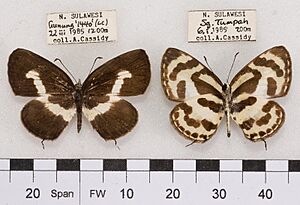Angled Pierrot facts for kids
Quick facts for kids Angled Pierrot |
|
|---|---|
 |
|
| Set specimens, Sulawesi | |
| Conservation status | |
| Scientific classification | |
| Synonyms | |
|
The Angled Pierrot (scientific name: Caleta caleta) is a beautiful blue butterfly. It belongs to the Lycaenidae family, which includes many small, colorful butterflies. You can find this special butterfly in Sulawesi.
Contents
What Does the Angled Pierrot Look Like?
The male Angled Pierrot has a dark brownish-black color on its upper side. A wide, slanted white band crosses both its front and back wings. This band forms a hook-like shape on the front wing.
The underside of the butterfly is white with black patterns. On the front wing, there are black marks like a club-shaped streak near the base. There's also a large, irregular black spot near the bottom corner.
On the back wing, you'll see a hook-shaped mark near the base. There are also several black spots that sometimes join together. The edges of the wings have thin, crescent-shaped lines. The antennae, head, and body are black, but the underside of its mouthparts and body are white.
The female Angled Pierrot looks very similar to the male. However, the white band on her upper side is a bit narrower. Also, the black markings on her underside are wider than the male's.
Where Do Angled Pierrots Live?
This butterfly species is found in several places. You can spot them in southern Sulawesi, an island in Indonesia. They also live on the islands of Basilan and Mindanao in the Philippines.
How Do Angled Pierrots Behave?
Angled Pierrot butterflies are very fast flyers. They usually fly close to the ground. You can often see them visiting low bushes. They like to hang out along small streams (called nullahs) and shady paths.
These butterflies also enjoy visiting damp patches of ground. They are typically found in jungles and lightly forested areas. These places usually have moderate to heavy rainfall, which the butterflies prefer.
The Life Cycle of the Angled Pierrot
Like all butterflies, the Angled Pierrot goes through several stages in its life.
The Caterpillar Stage (Larva)
The caterpillar of the Angled Pierrot feeds on the soft, new leaves of the Zizyphus rugosa plant. This plant is sometimes called "chorna." The caterpillar is pale green and has a shape similar to a woodlouse. This means its head is hidden under its second body segment. Its whole body is a bit fuzzy, and it has a fringe of longer hairs along each side.
The Chrysalis Stage (Pupa)
The chrysalis (or pupa) is short and sturdy. It has a slight constriction, or narrow part, between its chest (thorax) and abdomen. It's covered in short hairs. The chrysalis attaches itself firmly to a surface using its tail and a silk band. Its color is a yellowish-brown, often with brown spots. It looks similar to the chrysalis of another butterfly, Castalius ethion, but it has two green bands on its back.
The Adult Butterfly (Imago)
The adult butterfly is called an imago. If an Angled Pierrot develops during the dry season, it tends to be smaller. Its markings also appear less noticeable compared to those that develop during the wet season.
What Do Angled Pierrot Caterpillars Eat?
The main food plant for the Angled Pierrot caterpillar is:
- Zizyphus rugosa, which belongs to the Rhamnaceae family.
See also
- Caleta decidia, a blue butterfly species
- List of butterflies of India (Lycaenidae)


